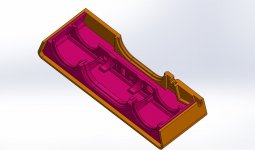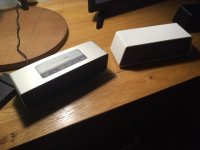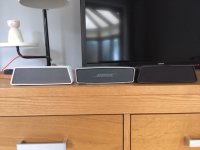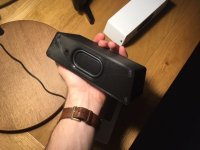Hi All,
I've been working on my own Bluetooth speaker design for a while now. Having tested a bunch of different drivers, amps, radiators and designs I'd finally got my project to where I was pretty happy with it. In the end I settled on these drivers (after testing several others including a Bose Soundlink Mini knock off): AIYIMA 2pcs 5W 40MM Mini Audio Portable Speakers 16 Core 4Ohm Full Range Speaker Rubber Side NdFeB Magnetic Loudspeaker|Combination Speakers| - AliExpress
and two of these radiators (front and back): AIYIMA 2Pcs Speaker Accessories Passive Bass Diaphragm Vibrating Plate Woofer Passive Radiator Vibration Membrane For DIY|Speaker Accessories| - AliExpress
The casing is 3-D printed in several parts and through some careful design the whole thing is very rigid - being held together with screws and made air tight with none other than good ol blue-tac (which works surprisingly well). A section of women's tights wraps around the inner casing to create the mesh. I've included a section view to give some idea of what's going on inside.
My reason for writing though is I stopped being happy when I compared the thing to my friend's Bose Sound-link mini. Now I've seen plenty of tear-downs of this and the recipe is fairly similar (two drivers and two radiators) and I'm also aware that it is a much more expensive speaker from a reputable company - but this didn't help my disappointment when I realised the HUGE difference in the bass department. The highs were fairly comparable and of a similar volume but the bass from the Bose adds so much to the sound stage that it makes mine seem lacking afterwards.
I'm not expecting to achieve the same thing but if anyone had some pointers on what to try I'd be very grateful. I could only think to maybe add some weight to the passive radiators. Unfortunately the Bose isn't mine to take apart and weigh the components of. I intend to sell these speakers as kits (just requires a screwdriver) for drastically less than the Bose but it would be great if the sound was full and deep like it. Perhaps I should have never compared the two - it sounded pretty good until then!
Also if anyone thinks there would be a market for these (bluetooth speaker kit/educational slant, usb-c charging, 12hrs battery, etc.) then I'd be grateful for any general feedback.
Thanks all,
Jonny
I've been working on my own Bluetooth speaker design for a while now. Having tested a bunch of different drivers, amps, radiators and designs I'd finally got my project to where I was pretty happy with it. In the end I settled on these drivers (after testing several others including a Bose Soundlink Mini knock off): AIYIMA 2pcs 5W 40MM Mini Audio Portable Speakers 16 Core 4Ohm Full Range Speaker Rubber Side NdFeB Magnetic Loudspeaker|Combination Speakers| - AliExpress
and two of these radiators (front and back): AIYIMA 2Pcs Speaker Accessories Passive Bass Diaphragm Vibrating Plate Woofer Passive Radiator Vibration Membrane For DIY|Speaker Accessories| - AliExpress
The casing is 3-D printed in several parts and through some careful design the whole thing is very rigid - being held together with screws and made air tight with none other than good ol blue-tac (which works surprisingly well). A section of women's tights wraps around the inner casing to create the mesh. I've included a section view to give some idea of what's going on inside.
My reason for writing though is I stopped being happy when I compared the thing to my friend's Bose Sound-link mini. Now I've seen plenty of tear-downs of this and the recipe is fairly similar (two drivers and two radiators) and I'm also aware that it is a much more expensive speaker from a reputable company - but this didn't help my disappointment when I realised the HUGE difference in the bass department. The highs were fairly comparable and of a similar volume but the bass from the Bose adds so much to the sound stage that it makes mine seem lacking afterwards.
I'm not expecting to achieve the same thing but if anyone had some pointers on what to try I'd be very grateful. I could only think to maybe add some weight to the passive radiators. Unfortunately the Bose isn't mine to take apart and weigh the components of. I intend to sell these speakers as kits (just requires a screwdriver) for drastically less than the Bose but it would be great if the sound was full and deep like it. Perhaps I should have never compared the two - it sounded pretty good until then!
Also if anyone thinks there would be a market for these (bluetooth speaker kit/educational slant, usb-c charging, 12hrs battery, etc.) then I'd be grateful for any general feedback.
Thanks all,
Jonny
Attachments
Online reviews reveal that the Bose has significant output down to about 70 Hz. Your AIYIMA speakers claim a response starting at 150 Hz, roughly an octave higher. That's not encouraging. Maybe you can add mass to the AIYIMA and lower the resonant frequency from 167 Hz to less than half that, but that will reduce sensitivity a bunch, and require much more amplifier power, which might cook the speakers since they're only rated at 5W.
Speakers in an enclosure with a passive radiator need to be modeled as an electro-mechanical system; the air in the box acts as a spring which the mass of the passive radiator "bounces" on. First thing, obtain legible Thiele-Small parameters from potential candidate speakers, then use a speaker design program to design a ported box, maybe a 6th order with line-level active equalizer, and see if you can create something close to the Bose.
If you find a promising candidate, get some samples, and measure them to confirm the T-S parameters are accurate. It's not unusual for published parameters to be a long way from what is in the box, thanks to manufacturing changes and revisions. Repeat the box design using the corrected parameters. Build a prototype box with a passive radiator instead of a port, and tune the passive radiator to the port frequency. This could mean adding or removing weight.
Add analog signal processing if necessary for a 6th order system, and to enhance the stereo effect, and see if the results are satisfactory.
Speakers in an enclosure with a passive radiator need to be modeled as an electro-mechanical system; the air in the box acts as a spring which the mass of the passive radiator "bounces" on. First thing, obtain legible Thiele-Small parameters from potential candidate speakers, then use a speaker design program to design a ported box, maybe a 6th order with line-level active equalizer, and see if you can create something close to the Bose.
If you find a promising candidate, get some samples, and measure them to confirm the T-S parameters are accurate. It's not unusual for published parameters to be a long way from what is in the box, thanks to manufacturing changes and revisions. Repeat the box design using the corrected parameters. Build a prototype box with a passive radiator instead of a port, and tune the passive radiator to the port frequency. This could mean adding or removing weight.
Add analog signal processing if necessary for a 6th order system, and to enhance the stereo effect, and see if the results are satisfactory.
Thanks both, I ended up adding some weight to the PRs which definitely made the speaker more responsive at lower frequencies. It isn't very feasible for me to repeat in larger production quantities unless I can have them tweaked directly by the manufacturer. Comparing the original speaker to others in its price bracket and it compares much more favourably. I will take your advice for development on a successor as this seems a good way to approach it. Any thoughts on the design itself?




